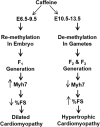Long-term consequences of disrupting adenosine signaling during embryonic development
- PMID: 28202385
- PMCID: PMC5487283
- DOI: 10.1016/j.mam.2017.02.001
Long-term consequences of disrupting adenosine signaling during embryonic development
Abstract
There is growing evidence that disruption in the prenatal environment can have long-lasting effects on an individual's health in adulthood. Research on the fetal programming of adult diseases, including cardiovascular disease, focuses on epi-mutations, which alter the normal pattern of epigenetic factors such as DNA methylation, miRNA expression, or chromatin modification, rather than traditional genetic alteration. Thus, understanding how in utero chemical exposures alter epigenetics and lead to adult disease is of considerable public health concern. Few signaling molecules have the potential to influence the developing mammal as the nucleoside adenosine. Adenosine levels increase rapidly with tissue hypoxia and inflammation. Adenosine antagonists including the methlyxanthines caffeine and theophylline are widely consumed during pregnancy. The receptors that transduce adenosine action are the A1, A2a, A2b, and A3 adenosine receptors (ARs). We examined the long-term effects of in utero disruption of adenosine signaling on cardiac gene expression, morphology, and function in adult offspring. One substance that fetuses are frequently exposed to is caffeine, which is a non-selective adenosine receptor antagonist. Over the past several years, we examined the role of adenosine signaling during embryogenesis and cardiac development. We discovered that in utero alteration in adenosine action leads to adverse effects on embryonic and adult murine hearts. We find that cardiac A1ARs protect the embryo from in utero hypoxic stress, a condition that causes an increase in adenosine levels. After birth in mice, we observed that in utero caffeine exposure leads to abnormal cardiac function and morphology in adults, including an impaired response to β-adrenergic stimulation. Recently, we observed that in utero caffeine exposure induces transgenerational effects on cardiac morphology, function, and gene expression. Our findings indicate that the effects of altered adenosine signaling are dependent on signaling through the A1ARs and timing of disruption. In addition, the long-term effects of altered adenosine signaling appear to be mediated by alterations in DNA methylation, an epigenetic process critical for normal development.
Keywords: Caffeine; Cardiac; Cardiomyopathy; Heart disease; Transgenerational.
Copyright © 2017 Elsevier Ltd. All rights reserved.
Figures


Similar articles
-
Embryonic caffeine exposure acts via A1 adenosine receptors to alter adult cardiac function and DNA methylation in mice.PLoS One. 2014 Jan 27;9(1):e87547. doi: 10.1371/journal.pone.0087547. eCollection 2014. PLoS One. 2014. PMID: 24475304 Free PMC article.
-
Adverse and protective influences of adenosine on the newborn and embryo: implications for preterm white matter injury and embryo protection.Pediatr Res. 2011 Apr;69(4):271-8. doi: 10.1203/PDR.0b013e31820efbcf. Pediatr Res. 2011. PMID: 21228731 Free PMC article. Review.
-
Regulation of cardiovascular development by adenosine and adenosine-mediated embryo protection.Arterioscler Thromb Vasc Biol. 2012 Apr;32(4):851-5. doi: 10.1161/ATVBAHA.111.226811. Arterioscler Thromb Vasc Biol. 2012. PMID: 22423036 Free PMC article. Review.
-
Caffeine acts via A1 adenosine receptors to disrupt embryonic cardiac function.PLoS One. 2011;6(12):e28296. doi: 10.1371/journal.pone.0028296. Epub 2011 Dec 2. PLoS One. 2011. PMID: 22164264 Free PMC article.
-
Early exposure to caffeine affects gene expression of adenosine receptors, DARPP-32 and BDNF without affecting sensibility and morphology of developing zebrafish (Danio rerio).Neurotoxicol Teratol. 2011 Nov-Dec;33(6):680-5. doi: 10.1016/j.ntt.2011.08.010. Epub 2011 Sep 3. Neurotoxicol Teratol. 2011. PMID: 21914471
Cited by
-
Dietary adenosine supplementation improves placental angiogenesis in IUGR piglets by up-regulating adenosine A2a receptor.Anim Nutr. 2023 Feb 22;13:282-288. doi: 10.1016/j.aninu.2023.02.003. eCollection 2023 Jun. Anim Nutr. 2023. PMID: 37168450 Free PMC article.
-
Impacts of Caffeine during Pregnancy.Trends Endocrinol Metab. 2020 Mar;31(3):218-227. doi: 10.1016/j.tem.2019.11.004. Epub 2019 Dec 6. Trends Endocrinol Metab. 2020. PMID: 31818639 Free PMC article. Review.
-
Toxicoepigenetics and Environmental Health: Challenges and Opportunities.Chem Res Toxicol. 2022 Aug 15;35(8):1293-1311. doi: 10.1021/acs.chemrestox.1c00445. Epub 2022 Jul 25. Chem Res Toxicol. 2022. PMID: 35876266 Free PMC article. Review.
-
Transient Disruption of Adenosine Signaling During Embryogenesis Triggers a Pro-epileptic Phenotype in Adult Zebrafish.Mol Neurobiol. 2018 Aug;55(8):6547-6557. doi: 10.1007/s12035-017-0850-6. Epub 2018 Jan 11. Mol Neurobiol. 2018. PMID: 29327202
-
Inhibition of ecto-5'-nucleotidase and adenosine deaminase is able to reverse long-term behavioural effects of early ethanol exposure in zebrafish (Danio rerio).Sci Rep. 2020 Oct 20;10(1):17809. doi: 10.1038/s41598-020-74832-0. Sci Rep. 2020. PMID: 33082435 Free PMC article.
References
-
- Cetin I, Mando C, Calabrese S. Maternal predictors of intrauterine growth restriction. Current opinion in clinical nutrition and metabolic care. 2013;16:310–319. - PubMed
-
- Gluckman PD, Cutfield W, Hofman P, Hanson MA. The fetal, neonatal, and infant environments-the long-term consequences for disease risk. Early Hum Dev. 2005;81:51–59. - PubMed
-
- Barker DJ. Human growth and cardiovascular disease. Nestle Nutr Workshop Ser Pediatr Program. 2008;61:21–38. - PubMed
-
- Barker DJ. Fetal origins of cardiovascular disease. Ann Med. 1999;31(Suppl 1):3–6. - PubMed
Publication types
MeSH terms
Substances
Grants and funding
LinkOut - more resources
Full Text Sources
Other Literature Sources
Miscellaneous

